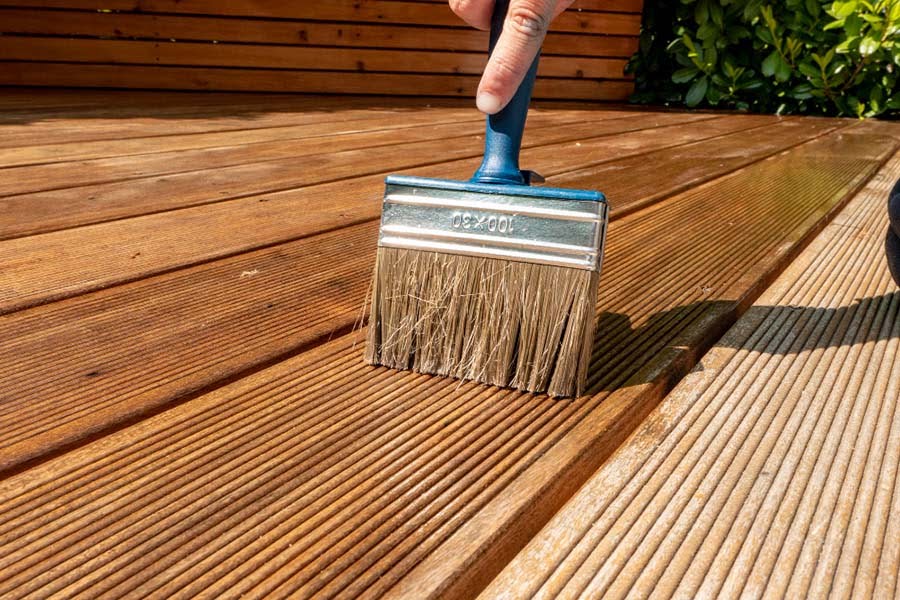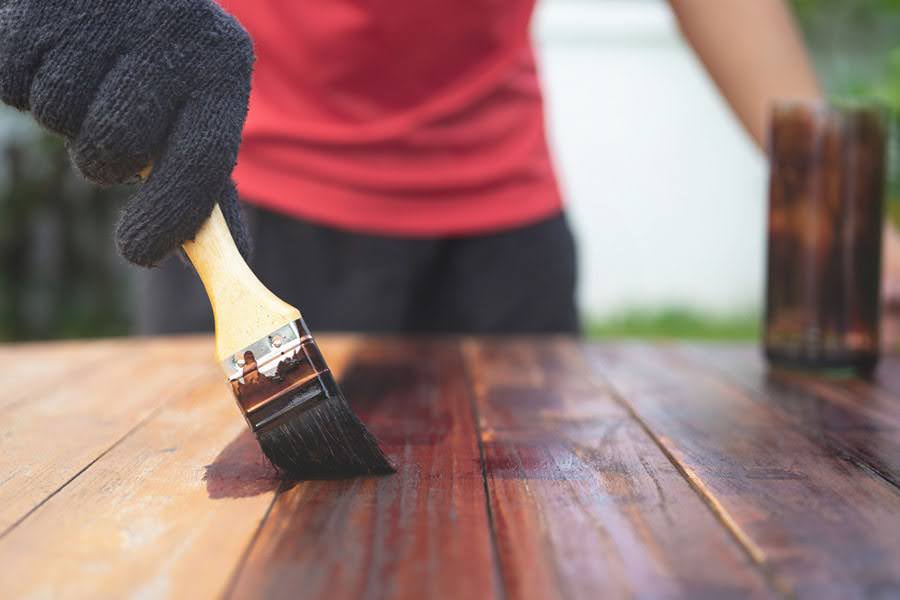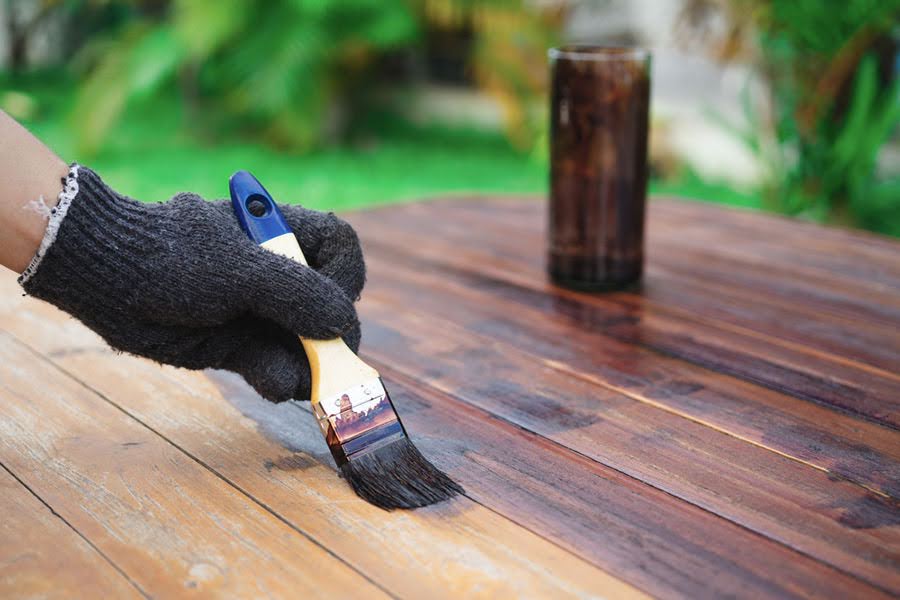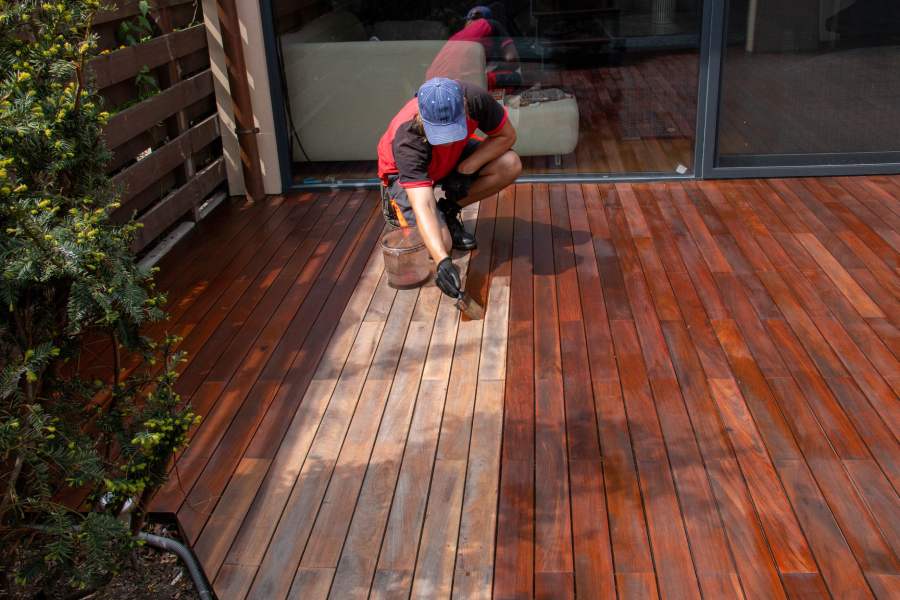Imagine your deck basking in the warm glow of a summer sunset, its rich colors inviting you to linger longer outdoors. But maintaining that allure requires more than just good weather. Deck staining is crucial in preserving its beauty and durability against the elements. But what is deck staining? What are its benefits?
In this article, we’ll explore the world of deck staining, examining its role in deck care and its impact on the longevity and appearance of these popular outdoor features. We will help you make informed decisions about your deck’s care and maintenance.

What Is Deck Staining and Sealing?
Deck staining and sealing are processes used to protect and enhance the appearance of wooden decks. Staining involves applying a colored pigment to the wood, which can enhance its natural grain and provide UV protection.
Sealing, however, involves applying a protective clear coat over the stained or natural wood to prevent moisture penetration, rotting, and weather damage. Together, staining and sealing help prolong the deck’s life and maintain its aesthetic appeal.
Purpose of deck staining
Deck staining has several important purposes. First, it protects the wood from damage by blocking the sun’s rays and keeping water out, preventing it from turning gray, warping, or rotting.
Staining also enhances the deck’s appearance by bringing out the natural beauty of the wood with deeper, richer colors. Lastly, staining helps your deck last longer by protecting the wood from damage, saving you money on repairs.
Types of Deck Stains
You have several options when choosing a stain for your wood. For example, transparent stains reveal the natural wood grain beautifully but typically need reapplication every one to two years.
Semi-transparent stains offer more color and better UV protection, lasting around two to three years. If you prefer more coverage, solid stains completely hide the wood grain and provide excellent UV protection for up to five years, but they require thorough preparation and professional application.
For longevity and deep wood penetration, oil-based stains are ideal. They offer superior protection but have longer drying times and more challenging cleanup.
On the other hand, water-based stains are easier to apply and clean up quickly. They dry faster and are more environmentally friendly, although they may not penetrate wood as deeply as oil-based stains.
Benefits of Deck Staining
Protection from weather damage
Staining your deck is like giving it a shield against the weather. It forms a protective layer that removes rain and snow, which is crucial because excessive water can damage the wood. Additionally, stain blocks the sun’s harmful rays, preventing the wood from turning gray or fading over time.
By repelling water and shielding from sunlight, staining prevents several issues. It stops the wood from warping, where boards twist out of shape, and reduces cracking and splintering. This enhances safety and makes your deck more comfortable to use.
Aesthetic appeal
Staining can make your deck look great by enhancing its natural beauty and showcasing its grain patterns. You have a variety of stain colors to choose from.
Clear stains allow the wood’s natural color to shine through, while tinted stains subtly alter the wood’s hue. In contrast, darker stains can significantly transform your deck’s appearance, allowing you to match it with your home or create a fresh outdoor aesthetic. By staining, you can rejuvenate an old deck, revitalizing your home’s appearance.

Preventing mold and mildew
Many deck stains contain ingredients that combat mold and mildew, types of fungi that thrive on damp wood. These growths detract from the deck’s appearance and might pose slip hazards and health concerns. Staining your deck helps maintain dryness, creating an environment less conducive to mold and mildew growth.
To ensure this protection, proper application of the stain is crucial. You should begin with a clean and dry deck before staining. You need to coat all surfaces evenly, particularly areas prone to water accumulation, such as where boards meet.
Ease of maintenance
A stained deck is easier to maintain, and dirt and leaves don’t stick to it as much, so it’s easier to clean. Often, you can just sweep it or spray it with a garden hose. When you do need to clean it more thoroughly, the stain makes this easier, too.
The smooth surface lets you remove dirt more easily. This means you don’t have to use harsh cleaning methods as often. Over time, this easy maintenance can save you money.
A well-maintained deck lasts longer, so you don’t have to replace boards or fix damage as often. This makes staining a smart choice for protecting your deck and saving money in the long run.
The Deck Staining Process
Preparation
Before you start staining your deck, you need to prepare it properly. First, remove all furniture and sweep the deck clean. Then, use a power washer to remove dirt and grime. Be careful not to set the pressure too high, which could damage the wood.
For tough stains, use a deck cleaner and scrub with a stiff brush. After cleaning, check for any raised nails or screws and fix them. You should sand any rough spots to make the surface smooth. Once you’re done cleaning and repairing, we recommend letting the deck dry completely.
Choosing the right stain
Choosing the right stain is key to achieving the best outcome. You should consider your deck’s wood type because absorption rates differ between species.
Another thing to take into account is your local climate. Places with a lot of sun need stains that protect against UV rays. Also, have in mind your preferred look: clear stains emphasize the wood’s grain, while solid stains come in various colors for more choices.
Application
When you’re ready to apply the stain, gather your tools: brushes, rollers, or a sprayer, depending on your preference and deck size. Stir the stain thoroughly before starting. Apply it in thin, even coats, following the wood grain.
You need to work on small sections at a time, using a brush for corners and cracks. If there are any puddles of stain, wipe them up with a rag.

Drying and curing
After you’ve applied the stain, let it dry and cure. Water-based stains dry faster than oil-based ones. However, even if the stain feels dry, wait longer before using the deck.
For water-based stains, wait at least 24 hours; for oil-based stains, wait 72 hours or more. The stain needs more time to cure fully. During this period, we advise you to avoid walking on the deck or placing furniture on it.
Conclusion
Now that you know what is deck staining, maintaining the beauty and durability of your outdoor living space will be easy. Deck staining involves applying a protective layer that shields the wood from weather damage, enhances its appearance, and extends its lifespan.
Whether you’re preserving a new deck or revitalizing an old one, understanding the staining process helps you make informed decisions about care and maintenance. So, are you still dreaming of transforming your outdoor space?
Our team specializes in deck design, construction, and maintenance, ensuring every detail of your vision is realized with excellence. Let us create the perfect outdoor retreat for you. Contact us today to start planning your dream deck!

